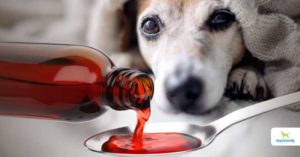Part 1: The Law Of Similars
Homeopathy is based on one simple principle: treat like with like.
This is called the law of similars. Hahnemann stressed that a disease can only be recognized by it’s symptoms and it is the totality of these symptoms which must be addressed. Whereas allopathic medicine works to suppress symptoms, the fundamental principle of homeopathy is disease will be cured by remedies that produce similar symptoms.
The goal of homeopathy is to select a remedy which best fits the symptom picture of the dog so that the artificially produced disease will restore balance or equilibrium in the body. This is not unlike the principles of acupuncture or Traditional Chinese Medicine. In this way, we can help the body to help itself.
The Law of Similars:
- Causative factors of a disease are important in proper diagnosis and treatment.
- Proving a substance – Plant, animal, mineral or biological -by testing it’s power to create symptoms in a healthy person, is the only logical method to introduce a homeopathic remedy.
- Stronger, similar symptoms induced by the homeopathic remedy are termed the artificial disease which can, in turn, control the natural disease. The homeopathic remedy is thus an artificial disease inducing agent.
- Two dissimilar diseases occurring at the same time ( a complex disease) cannot mutually cure one another, whereas two similar, but stronger diseases cannot coexist and cure can take place as they mutually destroy one another. ( Homeopathic cure)
- The untunement of the vital force or dynamis brings about disease. When these vital forces are in a balanced harmony ( tuned bioenergetic force) re-established by the homeopathic remedy, health will prevail.
- The totality of symptoms is the only indication to the choice of the correct remedy and that is, the sum total of the sensations and observable changes in the organism.
Preparing Remedies
The homeopathic remedy is an artificial disease inducing agent which works to stimulate the disease symptoms, not suppress them. This is completely backward to allopathic medicine. Dosing in homeopathy is also completely backward to allopathic medicine.
In homeopathy, the smallest dose of a remedy exerts far more healing power than a strong dose. In fact, homeopathic remedies are strongest when they are most dilute. The medicinal power of homeopathic remedies relies not on the material in the remedy but rather on the energy of the substances released through potentisation.
There are three steps to preparing homeopathic medicines:
Preparing the Mother Tincture. The Mother Tincture is the homeopathic medicine in its most concentrated form. The plant, animal, mineral or biological source is mixed with pure alcohol solution, aged and filtered.
Potentisation is the act of progressively diluting and succussing the Mother Tinctures to render the treatment safe from potentially poisonous side effects and to increase the therapeutic activity: the potency. The potency of a remedy is determined by two things: the number of times the Mother Tincture has been diluted and the number of times the remedy has been sucussed (shaking the remedy to impart energy).
The final stage is to administer the medication to the dog. Remedies may be delivered as pills, tablets, granules, suppositories, liquids, ointments or injectables. The most commonly found sources are small pills or pellets and liquid forms.
Potencies
There are two types of dilutions; Decimal and Centesimal. The decimal potencies are those labeled by the letter x (1x, 2x, 3x, 4x…etc) and the centesimal potencies are labeled with the letter c (3c, 6c, 30c, 200c…etc). It is important to note that the Roman numeral for ten is X and C is the Roman numeral for 100.
This means that the a 1x potency is one part Mother Tincture to 9 parts alcohol/water solution and the mixture is then succussed. To make a 2x solution, you would take a 1x solution in a new container and mix it with another 9 parts alcohol/water solution.
To create a 1c potency, you would take one part Mother Tincture and mix with 99 parts alcohol/water solution.
As an example:
1c = 1:100 or 1 part in 100
2c = 1:10 000 or 1 part in 10 000
3c = 1:1 000 000 or 1 part in 1 000 000
The third set of potency series is millesimal and that is indicated by the letter M (the Roman numeral for 1,000). The mm potencies are one part Mother Tincture to 999 parts alcohol/water solution.
1 mm is equal to 1:1,000
2 mm equals 1:1,000,000
Higher potencies are more time consuming to develop in this manner, so are manufactured with the less accurate and easily automated Korsakovian method. In general, potencies over 200c will be manufactured with the Korsakov method.
The potency of homeopathic remedies will be presented on the label as:
Decimal Series X (or x)
Centesimal Series C (or c or CH)
Centesimal Series (Korsakov) CK
High Potencies:
- 1,000c = 1M
- 10,000c = 10M
- 50,000c = 50M
- 100,000c CM
Storage
Homeopathic remedies are very sensitive because of the low medicinal content of medicament. For example granules, pills and tablets are simply coated with the particular remedy not made entirely of it. So the slightest mishandling can result in a remedy that is rendered ineffective.
Alcohol is necessary to maintain the efficacy of remedies. If not in an alcohol solution, remedies are useless in less than a few hours. Remedies prepared in water alone have no therapeutic activity.
Remedies should never be touched by the hands. The amino acids in the skin can render it useless.
Medicines should be contained in amber glass bottles and should be kept away from strong smells and odors such as essential oils, garlic, camphor, coffee and other such substances.
Potency and Dosage
The goal of homeopathy is to restore health rapidly, gently and permanently in the quickest and least harmful way. In order to achieve that goal you must find the remedy which best fits the totality of symptoms. Again as quoted from the Organon. A single symptom is no more the disease than a single foot is a man. This is an accurate description that disease is an intricate entity. Disease is a dis-ease in the body: an interruption of health and vitality. A interruption to the vital force.
If the particular remedy symptom picture covers the greatest number of complaints given by the patient and the totality of symptoms have been considered, then that remedy would be the best choice and side effects or aggravations should be insignificant. Having said that, even the best chosen remedy may create slight new symptoms because it is almost impossible for the symptoms of the remedy to exactly fit those of the disease.
Finding the right remedy is fundamental to the success of homeopathy. The Materia Medica is the remedy reference guide which outlines the properties of each remedy. Selecting the proper remedy is not the focus of this course, but you can easily find access to a Materia Medica online or by purchasing one from a bookstore.
Once the correct remedy is found, choice of potency will be important. The most widely used potencies are:
HIGH
1M
200C
MEDIUM
30C
LOW
6C
3X
In general, potencies are selected according to the following table:
Initial Prescription Frequency of Dosage
ACUTE DISEASE LOW (eg 6C) HIGH (eg hourly – 4 x per day)
CHRONIC DISEASE HIGH (eg 200C) LOW (1-2 x per week)
* Note that if you are treating for mental symptoms (constitutional prescribing), you would treat with higher doses but it is difficult to determine constitution for dogs so we will not mention that here
The table below shows that the potential for aggravation is usually lowest with medium potencies (eg 30C)

There are some general rules of thumb which will further help you select the right potency:
- The better the fit between the remedy and the disease symptoms, the higher the potency you should use
- The older the dog, the lower the potency
- The greater the degree of disease, the lower the potency
- The more pronounced the symptoms, the higher the potency
- The lower the overall vitality of the dog, the lower the potency
- The usual single dose for homeopathic remedies is three pellets or ten drops of liquid. Pills are best dissolved under the tongue and preferably not chewed. If this is not possible for your dog, then a liquid solution might be best.
Remedies are best taken between meals, when the mouth is clean. There is no need to wash it down with food or a drink.
Pills should not be handled as remedies are very sensitive to contamination. Tip the pellets into the lid of the container and administer from the lid.
Frequency Of Dosing
The frequency of dosing may be affected by the individual remedy (some remedies have a brief reaction time such as Aconite whereas Graphites has a longer reaction time).
When an improvement in condition is seen, the interval between doses should be increased.
When the condition is cleared or considerably improved, dosing should stop.
If another condition arises during treatment, another remedy should be selected.
A quality diet, fresh air, adequate rest and exercise will be of great value.












